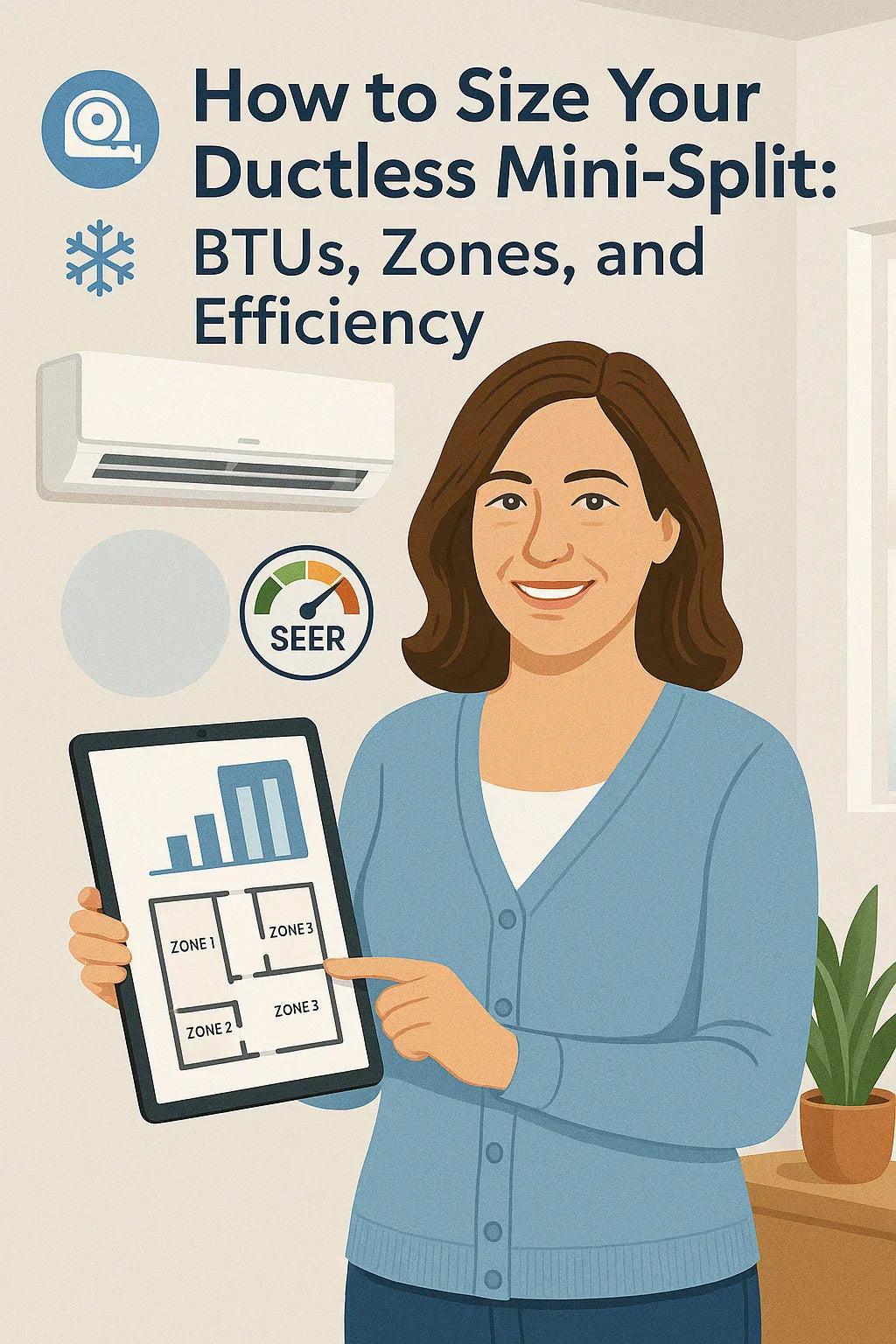🧩 Why Sizing Matters for Samantha
Sizing your ductless mini-split correctly ensures you get efficient, quiet, and comfortable heating and cooling without overspending on energy bills or ending up with uneven temperatures.
Oversizing leads to short cycling, higher humidity, and wasted energy. Undersizing leads to overworking your system and poor comfort. Samantha needs to balance capacity, zones, and efficiency to match her home's needs.
🔢 Understanding BTUs: The Basics
BTU (British Thermal Unit) measures the cooling or heating capacity of HVAC systems.
-
1 BTU = the amount of energy needed to raise the temperature of 1 lb of water by 1°F.
-
Mini-splits range from 6,000 to 48,000+ BTUs depending on application and zones.
Learn more about BTUs and HVAC here.
🗂️ Recommended BTUs by Room Size
Use these guidelines as a starting point:
| Room Size (sq. ft) | Recommended BTU |
|---|---|
| 150 - 250 | 6,000 - 7,000 |
| 250 - 300 | 7,000 - 8,000 |
| 300 - 350 | 8,000 - 9,000 |
| 350 - 400 | 9,000 - 10,000 |
| 400 - 450 | 10,000 - 12,000 |
| 450 - 550 | 12,000 - 14,000 |
| 550 - 700 | 14,000 - 18,000 |
| 700 - 1,000 | 18,000 - 24,000 |
| 1,000 - 1,200 | 24,000 - 30,000 |
Adjust based on: ✅ Ceiling height ✅ Insulation quality ✅ Number of windows and sun exposure ✅ Local climate ✅ Occupancy and heat-generating appliances
Mitsubishi’s BTU sizing guide can help refine calculations.
🪟 Single-Zone vs. Multi-Zone Considerations
Single-Zone Systems:
-
One outdoor unit + one indoor unit.
-
Ideal for home offices, garages, or additions.
-
Easier to install, lower upfront cost.
Multi-Zone Systems:
-
One outdoor unit + 2-8 indoor units.
-
Ideal for multi-room coverage (e.g., Samantha’s upstairs rooms and home office).
-
Each indoor unit can have independent settings.
-
Typically 18,000 - 48,000+ BTU total, split between zones.
Read about multi-zone systems and benefits here.
🌡️ Understanding SEER and HSPF
-
SEER (Seasonal Energy Efficiency Ratio): Measures cooling efficiency. Higher SEER = more efficiency.
-
HSPF (Heating Seasonal Performance Factor): Measures heating efficiency. Higher HSPF = better performance.
✅ Look for SEER ratings 19-30+. ✅ Look for HSPF ratings 9-12+. ✅ Systems with inverter technology adjust compressor speed to match demand, increasing efficiency.
Explore SEER and efficiency explained here.
📈 Real-World Example: Samantha’s Home Office
-
Size: 250 sq. ft
-
Good insulation, moderate sun exposure
-
Desired: Cooling + heating year-round
Recommended:
-
BTU: 7,000-8,000
-
System: Single-zone mini-split with heat pump
-
Efficiency: SEER 20+, HSPF 10+
This ensures quiet, efficient comfort while keeping Samantha’s energy bills low.
🛠️ Factors That Impact Sizing
✅ Climate Zone: Colder climates may require higher capacity for heating. ✅ Windows and Insulation: Poor insulation and large windows increase load. ✅ Room Usage: Kitchens and gyms generate more heat. ✅ Ceiling Height: Add 20% BTU if ceilings are 9 feet or higher. ✅ Sun Exposure: South-facing rooms may need 10% more BTU.
Use the Manual J calculation for precise load sizing here.
🚩 Common Mistakes to Avoid
🚫 Oversizing the system: Leads to short cycling, higher humidity, and energy waste. 🚫 Ignoring insulation quality: Bad insulation increases load requirements. 🚫 Not accounting for sun exposure: Bright, sunny rooms require more capacity. 🚫 Forgetting ceiling height: Higher ceilings increase volume, requiring additional BTU. 🚫 Underestimating heating needs in cold climates: Some mini-splits have reduced capacity below 20°F unless rated for low ambient heating.
🛡️ When to Call a Professional
While online tools help, a professional HVAC contractor can: ✅ Perform Manual J load calculations. ✅ Inspect your home’s insulation and airflow. ✅ Help plan multi-zone layouts. ✅ Recommend models based on your climate and rebate opportunities.
This ensures Samantha maximizes her investment while avoiding costly mistakes.
💰 Efficiency and Cost Considerations
✅ Higher SEER and HSPF ratings cost more upfront but save money long-term. ✅ Multi-zone systems reduce the need to heat/cool unused areas. ✅ Ductless mini-splits often qualify for federal and local rebates. ✅ Inverter systems avoid energy waste during part-load operation.
Check current rebates at DSIRE.
✅ Conclusion: Samantha’s Next Steps
To size her ductless mini-split correctly, Samantha should:
1️⃣ Measure each room’s square footage. 2️⃣ Note ceiling heights, windows, insulation, and sun exposure. 3️⃣ Use BTU guidelines to estimate capacity. 4️⃣ Decide if she needs single-zone or multi-zone coverage. 5️⃣ Choose a system with high SEER and HSPF ratings. 6️⃣ Use online tools or call a professional for a detailed load calculation. 7️⃣ Check available rebates to lower upfront costs.
Correct sizing ensures quiet comfort, lower energy bills, and long-term efficiency in Samantha’s home.
📲 Ready to Shop?
Explore Ductless Mini-Splits at The Furnace Outlet to find systems that match your sizing and efficiency needs perfectly.
In the next topic we will read more about: What Does a Ductless Mini-Split Installation Cost in 2025? Real-World Estimates & Budgeting







